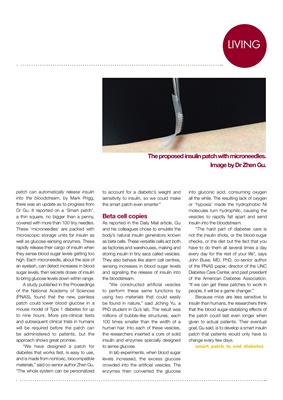
LIVING
The proposed insulin patch with microneedles.
Image by Dr Zhen Gu.
patch can automatically release insulin
into the bloodstream, by Mark Prigg,
there was an update as to progress from
Dr Gu. It reported on a 'Smart patch',
a thin square, no bigger than a penny,
covered with more than 100 tiny needles.
These 'microneedles' are packed with
microscopic storage units for insulin as
well as glucose-sensing enzymes. These
rapidly release their cargo of insuiln when
they sense blood sugar levels getting too
high. Each microneedle, about the size of
an eyelash, can detect increases in blood
sugar levels, then secrete doses of insulin
to bring glucose levels down within range.
A study published in the Proceedings
of the National Academy of Sciences
(PNAS), found that the new, painless
patch could lower blood glucose in a
mouse model of Type 1 diabetes for up
to nine hours. More pre-clinical tests
and subsequent clinical trials in humans
will be required before the patch can
be administered to patients, but the
approach shows great promise.
"We have designed a patch for
diabetes that works fast, is easy to use,
and is made from nontoxic, biocompatible
materials," said co-senior author Zhen Gu.
"The whole system can be personalized
to account for a diabetic's weight and
sensitivity to insulin, so we could make
the smart patch even smarter."
Beta cell copies
As reported in the Daily Mail article, Gu
and his colleagues chose to emulate the
body's natural insulin generators known
as beta cells. These versatile cells act both
as factories and warehouses, making and
storing insulin in tiny sacs called vesicles.
They also behave like alarm call centres,
sensing increases in blood sugar levels
and signaling the release of insulin into
the bloodstream.
"We constructed artificial vesicles
to perform these same functions by
using two materials that could easily
be found in nature," said Jiching Yu, a
PhD student in Gu's lab. The result was
millions of bubble-like structures, each
100 times smaller than the width of a
human hair. Into each of these vesicles,
the researchers inserted a core of solid
insulin and enzymes specially designed
to sense glucose.
In lab experiments, when blood sugar
levels increased, the excess glucose
crowded into the artificial vesicles. The
enzymes then converted the glucose
into gluconic acid, consuming oxygen
all the while. The resulting lack of oxygen
or 'hypoxia' made the hydrophobic NI
molecules turn hydrophilic, causing the
vesicles to rapidly fall apart and send
insulin into the bloodstream.
"The hard part of diabetes care is
not the insulin shots, or the blood sugar
checks, or the diet but the fact that you
have to do them all several times a day
every day for the rest of your life", says
John Buse, MD, PhD, co-senior author
of the PNAS paper, director of the UNC
Diabetes Care Center, and past president
of the American Diabetes Association.
"If we can get these patches to work in
people, it will be a game changer."
Because mice are less sensitive to
insulin than humans, the researchers think
that the blood sugar-stabilizing effects of
the patch could last even longer when
given to actual patients. Their eventual
goal, Gu said, is to develop a smart insulin
patch that patients would only have to
change every few days.
smart_patch_to_end_diabetes